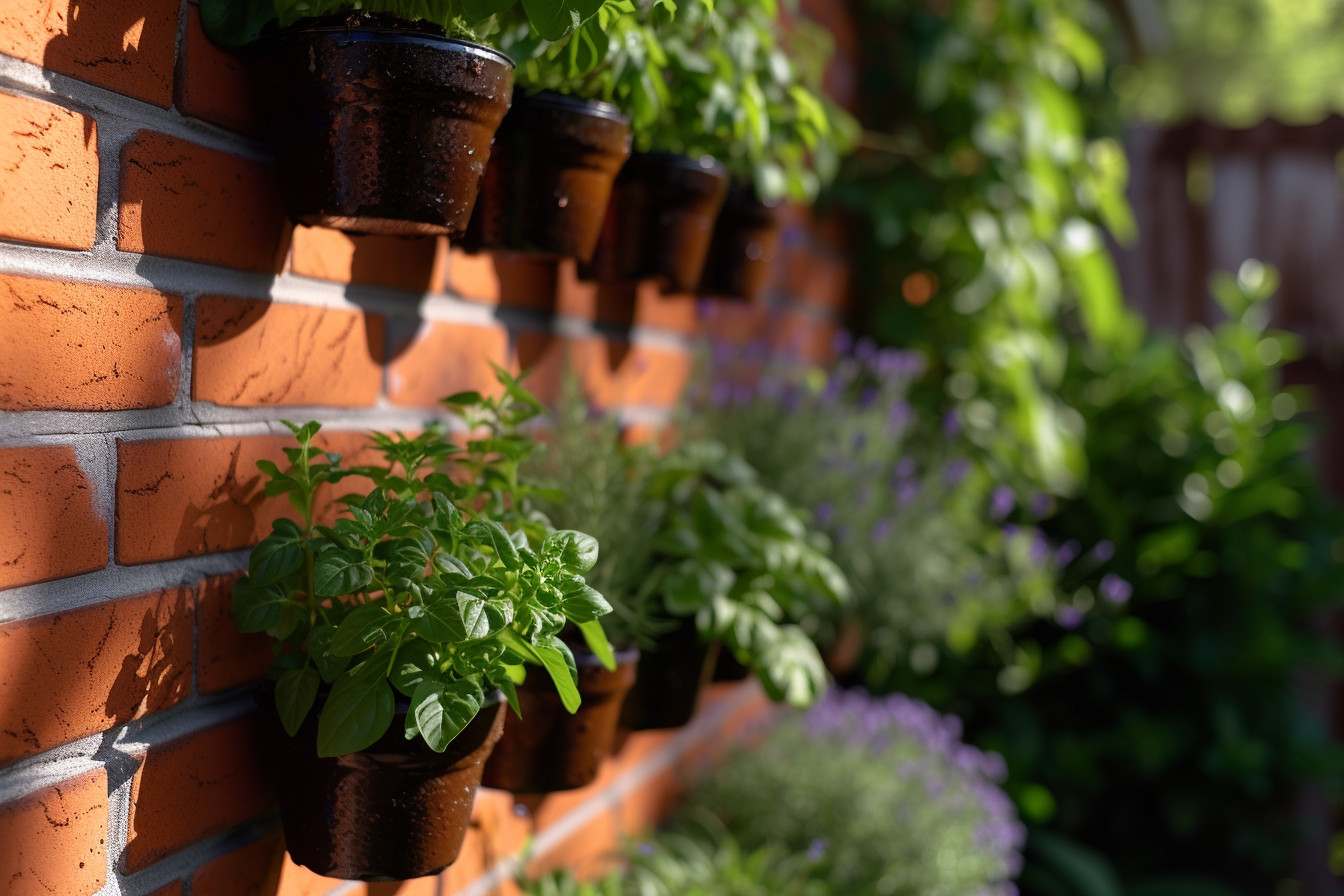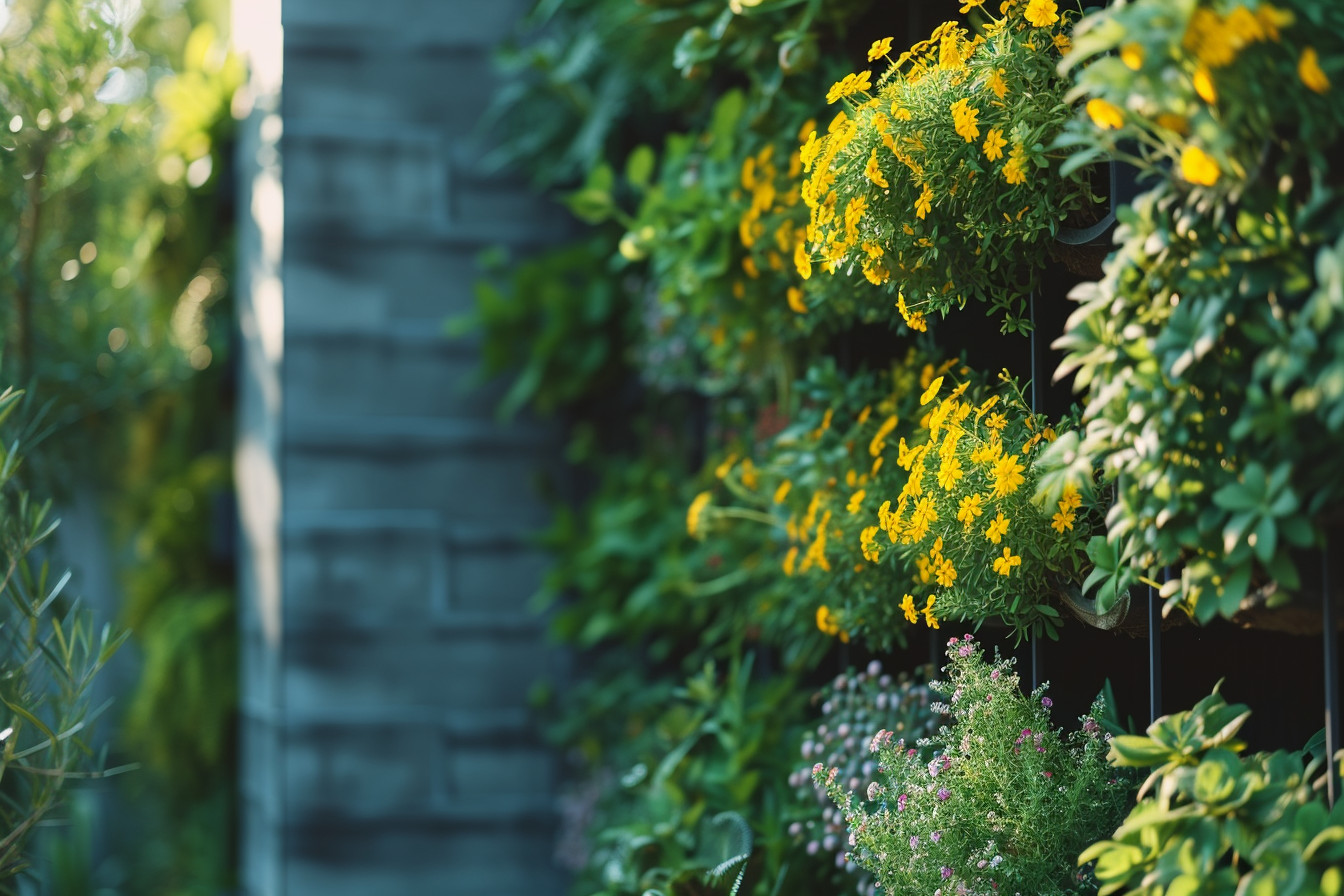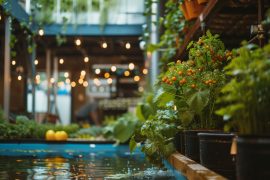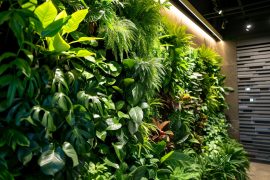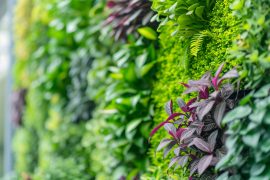Vertical gardens aren’t just about tossing a few plants on a wall and calling it a day. They’re an art form, blending the lush greenery of nature with human creativity to create living masterpieces that breathe life into our urban environments. I’ve always been fascinated by how these vertical oases can transform mundane spaces into stunning displays of beauty and tranquility.
There’s something incredibly peaceful about being surrounded by plants, isn’t there? As someone deeply immersed in gardening myself, taking care of my little leafy friends has become almost meditative. It’s this connection between peace found in nature and creative expression that makes me excited about sharing everything there is to know regarding incorporating aesthetics through vertical gardens.
From selecting the right species of plants for your climate zone to understanding the technicalities behind soil nutrition and sunlight exposure, it all comes together beautifully when you understand each aspect well enough.
Oh! And let’s not forget one crucial thing: anyone can integrate artwork within their garden, making every space unique while also contributing positively towards mental health through natural connectivity.
Benefits of Vertical Gardens
Stepping into the world of vertical gardens feels like entering a green oasis where art meets horticulture in the most beautiful ways imaginable. It’s not just about adding splashes of color to urban landscapes; these living walls bring with them a host of benefits that extend far beyond mere aesthetics.
Let me paint you a picture: imagine your own little slice of Eden, tucked away on an otherwise blank and boring city wall. Sounds pretty amazing, right? Well, it turns out there are solid reasons why people across the globe are falling head over heels for vertical gardening, apart from their obvious charm and beauty.
First off, they’re incredible space-savers. In cities where every square inch counts., going up is often the only way left! Bringing nature into dense urban areas isn’t always straightforward, but through skyward planting strategies, everything changes. Plus, giving us something gorgeous to gaze at as we sip our morning coffee adds another layer of peace to our day!
And let’s not forget the cooling effects! With rising global temperatures, shadier, leafier surroundings have become ever-sought-after treasure troves of coolness. During the warm season, water-retained foliage evaporates, lowering the nearby ambient temperature.
Voila instant microclimate adjustment whenever you need a chill break Life amidst greens could thus help cut down on AC costs too. Double-whammy energy-saving environmental friendliness if you ask me
So next time you stumble upon a vibrant, magnificent piece, think of all the hidden perks working silently in the background, basking under layers of leaves, flowers, and vine buds. Certainly appreciating now, huh?
Beyond Just Plants: Incorporating Art in Vertical Gardens
Diving right into the heart of vertical gardening, it’s clear that these living works of art offer more than just a green aesthetic. They’re canvases waiting for creative minds to explore and enhance with artistic elements. Imagine wandering through a lush garden only to discover hidden sculptures or intricately designed mosaics nestled among the plants—it’s like stumbling upon treasure.
One intriguing way folks have started merging art with their vertical gardens is by integrating small sculptures or whimsical figures that peek out from behind leaves and vines. It can turn an ordinary wall into an interactive experience! There are stories about individuals who’ve used metallic birds, fairy figurines, or even miniature climbers scaling the foliage—each piece adding personality and depth.
But let’s talk materials because not everything will withstand outdoor conditions if you’re looking outside. Ceramics made for exterior use, weatherproof painted items—people get super inventive here—incorporating anything from repurposed bits n’ bobs to custom-made glass pieces reflecting sunlight beautifully across your space!
There’s also this amazing trend where artists create murals as backdrops before planting begins, so when those greens start growing, they seem almost enchanted against vibrant paintings beneath them—a concept seriously catching on in urban areas—turning bland walls fabulously biodiverse.
Choosing the Right Plants for Aesthetic Appeal
Picking out plants is like curating art for a gallery. Each plant brings its own splash of color, texture, and form; together, they create a living mosaic that can transform any space into an enchanting garden retreat. But it’s not just about slapping together some pretty flowers; there’s an art to selecting species that will thrive while delivering on looks.
First up, let’s talk color coordination, because who doesn’t love a visual feast? Imagine strolling through your vertical garden, bathed in shades ranging from soothing blues and purples to invigorating yellows and reds. To get this right involves picking plants known not only for their vibrant colors but also for how these hues play off each other throughout the seasons.
Succulents offer year-round greens with surprises—think Echeveria ‘Blue Prince’ or Sedum ‘Firestorm’. For those pops of seasonal colors, spring bulbs such as tulips or daffodils kick things off early in the year, followed by summer bloomers like petunias.
Designing a Vertical Garden with Beauty in Mind
When diving into the world of vertical gardens, it’s not just about piling on plants against a wall. It’s an art form that combines nature and aesthetics to create peaceful spaces where stress feels like it dissolves away. So how do you start designing one with beauty as your main focus? Let me break down some ideas for you.
First things first—consider what vibe you’re going for. Want something lush and tropical, or are minimalistic ferns more your style? Your choice of plant plays a huge role in setting the tone. Take peace lilies or snake plants; they’re not only purifiers but also add this serene green elegance wherever they are placed.
Now let’s talk structure because, oh boy, does this make a difference! You can go traditional with baskets hanging at different levels (simple yet effective), install shelves to arrange smaller pots creatively, or even get crafty with recycled materials like old frames filled with succulents—a personal favorite trick up my sleeve!
Here comes lighting—and trust me—it drastically transforms any garden space, beaming life into every leaf corner piece by shining a spotlight, literally bringing photosynthesis party time all day long.
- Ambient soft lights create dramatic shadows, elongating agonizingly beautiful evenings.
- Direct sunlight zones are crucial for those sun-loving specimens, ensuring they thrive splendidly.
Lastly, never overlook textures with contrasting sharp angles. Cacti juxtaposed with silky petals create visual candy, enticing anyone who glances over, but don’t take my word; try to see yourself. Magic unfolds when elements play together harmoniously, blending and balancing themselves naturally. Ain’t got love, Mother Nature sense humor?
In weaving stories through each layer, vertical gardening becomes an adventure and discovery, and the adore moment realizes, ‘Hey, having hands in the soil and hearing birds chirping is kind of therapeutic’. Whether experimenting with tiny balconies and vast yard principles remain celebrating diversity, exploring endless possibilities, bonding tidbits of earth, nurturing care and grace, and giving us a tidbit of love, cherish it immensely.
Incorporating Color and Texture in Vertical Gardens
Vertical gardens aren’t just about packing a bunch of plants onto a wall. They’re art, blending color and texture into living masterpieces that breathe life into any space they occupy. When you start planning one, the world’s your oyster—there are endless possibilities to create something truly unique.
Let’s dive right in with color theory—it plays a huge role here! Considering complementary colors can make your vertical garden pop, while using analogous colors creates soothing visual harmony. For instance, pairing purples with yellows adds contrast and vibrance, making each hue stand out more sharply against its partner. On the flip side, grouping greens next to blues forms relaxing visuals perfect for contemplative or serene spaces.
Texture’s another game changer; it gives dimensionality to your green wall. Broad-leaf ferns paired beside fine misty sprays of baby’s breath introduce drama through disparity. Glossy leaves reflect light differently than matte succulents, adding layers seen not just during daylight but under nighttime illumination as well.
Such diversity invites touch, encouraging closer interaction between the viewer and nature. It brings us back down from our hectic lives, reminding us that there’s beauty in detail if we take the time to acknowledge it.
Textures don’t stop at plant types. I’ve played around integrating different materials, like moss, wooden shingles, pebbles, and even fabric. Introducing these elements isn’t only visually appealing; it also provides diverse habitats, allowing a broader selection of flora to thrive. And let me tell you, watching how this mixture evolves over the seasons is nothing short of exciting, showing dynamics, growth, and decay coming full circle.
Remember, keeping conditions maintained ensures longevity and attraction. That means proper irrigation and enough sunlight, among others. But worry, I’ll help demystify those terms so everyone grasps the basic care requirements without prior knowledge.
By embracing variances, hues, and structures going beyond mere functional considerations, we infiltrate realms of aesthetic delight. In doing so, we enhance our emotional connection with our environment. The following tips will surely transport readers and viewers alike. tranquil, verdant sanctuaries beacon environmental stewardship. mindfulness amidst urban landscapes.
Creating a Focal Point with Artistic Elements
Imagine yourself wandering through a garden where each turn unveils another layer of beauty and surprise. That’s the magic you tap into when integrating artistic elements to create focal points in vertical gardens. Now, let’s dive deep, but keep it simple; after all, not everyone is familiar with these gardening terms.
One effective strategy? Blend sculpture or mural art amidst your green canvases. Picture this: A vibrant mosaic that peeks out from between lush ferns or an elegant stone statue surrounded by cascading vines. These aren’t just random placements; they’re strategic moves designed to draw the eye and elevate the overall aesthetic appeal of your space.
But how do we ensure these artworks don’t just look thrown together like an afterthought? The secret lies in balance and harmony—choosing pieces that resonate with nature rather than compete against it for attention.
- Sculptures should be organic, almost as if carved directly from the earth.
- Mural works best blend local fauna themes using natural pigments.
These decisions are guided more by intuition than strict planning—about feeling what fits perfectly within your existing set-up while aiming for those moments of ‘wow’ as guests discover hidden gems nestled among foliage.
Here’s something interesting I came across during my digs on sustainable practices (and which new gardeners will love). Incorporating recycled materials can add unique twists without breaking the bank! Imagine breathing life back into old metal gears transformed into stunning abstract sculptures towering among bamboo stalks. It speaks volumes about creativity meeting eco-consciousness!
Facts You Can Plant
| Material | Application |
|---|---|
| Wood | Statues and Installation Frames |
| Metal | Abstract Structures |
| Stone and ceramic | Pathway Accents |
Maintaining the Aesthetic Appeal of Vertical Gardens
Vertical gardens, also known as living walls, are not just a trend but a beautiful way to incorporate greenery into urban spaces. They’re like art installations where nature plays the lead role. But let’s be real—keeping them lush and vibrant requires more than admiring glances.
First off, choosing the right plants is half the battle won. Think about it: Not every plant thrives in vertical confinement. Some prefer sprawling across garden beds rather than climbing up walls or being potted in felt pockets on your balcony wall! Opt for species that have similar light and water needs; this ensures they all get along well under identical conditions, and boom—you’ve got yourself a problem-free palette!
Lighting can’t be overlooked either—it’s what keeps those beauties flourishing instead of turning into sad, leafy skeletons hanging off your wall (and we definitely don’t want that). Natural light is ideal but not always feasible, especially if you’re stuck with north-facing views or towering buildings around, stealing sunlight quicker than shade at noon on summer days.
But wait, there’s pruning—the unsung hero behind every picturesque gallery. Our vertical babies need trimming and shaping. Now again, think of state-of-the-art topiaries that meet hedge-trimming and leading-edge vitamins to encourage healthy growth appearances. Regular snips here prevent invasive conquests by enthusiastic climbers. Say bye-bye to untamed jungle vibes and hello to structured elegance.
Finally, remember that these ecosystems stand tall because their foundations matter. Root health, air circulation, soil quality—they set the stage for supreme Detach any dead, dying foliage. ensure compact planting doesn’t restrict breathability. vital nutrient supply Check moisture level consistency. eye signs of distress, such as parched earth and discolored leaves Your goal Keep ground empire thriving community wonders whisper tales of serene beauty.
Final Thought
Wrapping up our journey through the lush and vibrant world of vertical gardens, it’s clear they’re not just another trend. They stand at the intersection where art meets nature, showcasing how we can bring beauty into urban spaces in a way that feels both innovative and timelessly connected to ancient gardening traditions. I’ve walked you through every step, from historical roots stretching back centuries to cutting-edge designs flourishing on city walls today.
By now, you might see these living artworks differently. Maybe you’ll notice them more around your city or consider installing one yourself, but let me share some takeaways:
- Vertical gardens are for everyone, whether you have a sprawling outdoor space or a cozy indoor nook.
In diving deep into this green wonderland with all its serenity and contemplation opportunities., what stood out was their transformative power:
Spaces come alive, offering solace amidst concrete jungles.
Moods brighten, as studies suggest being closer to greenery boosts happiness levels.
Air quality improves, given plants’ natural knack for purification.
Personal Reflections
I’ve been blessed; my balcony garden has become my little sanctuary, and watching it evolve over the seasons brings an indescribable joy. There’s magic in nurturing something and witnessing its growth—it kind of mirrors life’s ups and downs yet reminds us about resilience and, ultimately, renewal.
Cherishing those peaceful mornings spent amongst hanging ivies and blooming flowers reaffirmed why integrating elements like water features enhances not just aesthetics but also imbues calmness, bringing us closer to Mother Nature even if we dwell within skyscrapers!.
So yeah,. Vertical Gardens? More than just pretty faces. A true testament to when humanity collaborates rather than competes with nature We create environments reflecting tranquility, strength, and undeniably exquisite charm, crafted meticulously by either seasoned horticulturists or novices alike—all united under a shared love for a greener tomorrow.
